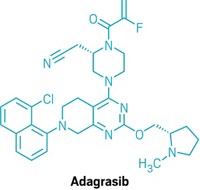Advertisement
Grab your lab coat. Let's get started
Welcome!
Welcome!
Create an account below to get 6 C&EN articles per month, receive newsletters and more - all free.
It seems this is your first time logging in online. Please enter the following information to continue.
As an ACS member you automatically get access to this site. All we need is few more details to create your reading experience.
Not you? Sign in with a different account.
Not you? Sign in with a different account.
ERROR 1
ERROR 1
ERROR 2
ERROR 2
ERROR 2
ERROR 2
ERROR 2
Password and Confirm password must match.
If you have an ACS member number, please enter it here so we can link this account to your membership. (optional)
ERROR 2
ACS values your privacy. By submitting your information, you are gaining access to C&EN and subscribing to our weekly newsletter. We use the information you provide to make your reading experience better, and we will never sell your data to third party members.
Business
Refueling A Biotech Growth Engine
As a key product stumbles at Amgen, the focus turns to the company's pipeline
by Lisa M. Jarvis
June 4, 2007
| A version of this story appeared in
Volume 85, Issue 23
SWEPT UP IN A CONTROVERSY that could erode sales of its top-selling product, Amgen is more reliant than ever on commercializing a steady flow of new drugs. That puts a spotlight on the firm's R&D engine, run by Joseph Miletich, senior vice president of research and development.
Stock analysts have been scrutinizing Amgen after recent reports that high doses of its anemia treatment Aranesp increase the risk of serious, sometimes deadly side effects in cancer patients. A Food & Drug Administration advisory committee recommended limiting the use of Aranesp and other erythropoiesis-stimulating agents (ESAs) to treat cancer, and the agency will soon set guidelines for how the drugs should be administered.
The financial pressure on Amgen mounted when the Centers for Medicare & Medicaid Services decided, in the absence of final word from FDA, to limit its coverage of ESAs. Analysts believe private insurers could follow suit, a move that would severely cut Aranesp's market.
With $4.1 billion in sales last year, Aranesp is Amgen's most important drug. Bank of America pharmaceutical analyst William Q. Sargent called the proposed Medicare and Medicaid restrictions "surprisingly severe" and lopped nearly $1 billion off of his 2009 forecast for Aranesp sales.
Before the pressure on Aranesp, Amgen would have needed to work to achieve even modest sales growth over the next several years. Now, its pipeline is more critical than ever. "A new product cycle is key," Morgan Stanley analyst Steven Harr underscored in a recent report on the company's first-quarter earnings.
Despite the uneasiness on Wall Street, Amgen seems to be staying focused on the science that made it the world's largest biopharmaceutical company. According to Miletich, R&D at Amgen remains centered on those elusive molecules that address uncharted disease pathways.
Miletich believes the hardest information to come by in drug discovery is a thorough understanding of the multiple steps in a disease pathway. As he explains, scientists can't reliably predict whether interrupting a particular step in that pathway will actually modulate disease. The only way to find out is through painstaking trial and error.
As such, the temptation—particularly in tough financial times—is to focus on biological targets that have already been through that trial and error process. But according to Miletich, Wall Street's stern gaze hasn't changed Amgen's commitment to elucidating new disease pathways. "The overwhelming number of molecules in our pipeline is designed to answer questions just like that," he says.
The most advanced pharmaceuticals in development at Amgen are tackling new targets, in some cases with completely new modes of delivery. Indeed, the firm's next drug likely to reach commercialization, AMG 531, ties together a new approach to both delivery and treatment.
AMG 531 is being developed to treat immune thrombocytopenic purpura (ITP), an autoimmune disease in which the body destroys platelets faster than it can make them. The conventional approach to treating ITP has been to try to slow the breakdown of platelets. But in a significant subset of patients, "you run out of ways to do that," Miletich says.
AMG 531, on the other hand, stimulates the bone marrow to make more platelets and shift the overall platelet count back to a normal range. "Most humans have the capacity to produce five to 10 times the number of blood cells we usually need and produce," Miletich points out.
Bank of America's Sargent expects AMG 531 to be launched next year, with sales growing to $350 million by 2012. Jim Reddoch, an analyst with Friedman, Billings, Ramsey, has an even more bullish forecast of almost $500 million in sales in 2012.
Though such sales volumes won't offset the potential Aranesp losses, the approval of AMG 531 would provide critical validation for a technology platform that is helping to populate Amgen's new drug pipeline. AMG 531 is a "peptibody," a drug composed of a peptide or several copies of a peptide that sit on the constant region of an antibody.
In theory, peptides make appealing therapeutic candidates because they tend to be less toxic than small molecules and more potent than antibodies. But in practice, their relevance as drugs has been limited by how quickly they are expelled from the body. "They're fairly small and exposed," Miletich notes.
Amgen's peptibody platform is an attempt to get the peptide to stay around longer and with the same efficacy. "Just sticking a peptide onto a larger protein platform doesn't necessarily mean it's going to work better than it did before," Miletich points out.
Although the conventional approach to enhancing peptide delivery has been to chemically link them to another vehicle—a polyethylene glycol chain, for example—Amgen actually "grows" the peptibodies in cells as an entire unit. Cell DNA is encoded with instructions to make the antibody with the peptides attached, a method that Miletich says could also bring down manufacturing costs.
A second peptibody, AMG 386, is in earlier stage trials for treating cancer. The drug binds to angiopoietins, growth factors that, like vascular endothelial growth factors (VEGF), enable blood vessels to grow. The VEGF pathway has been well-trodden in drug development; Genentech's Avastin, for example, targets VEGF. Amgen's peptibody would attempt to cut off the tumor's blood supply in the less-understood pathway.
Though the peptibody platform could produce Amgen's next marketed product, the firm's work in bone health seems more likely to lead to its next blockbuster. Denosumab, a monoclonal antibody in Phase III trials for treating osteoporosis, also fits into Amgen's strategy of thoroughly examining a disease pathway.
Through the denosumab discovery program, Amgen has developed "a much better understanding of the basic biology of how the body regulates bone," Miletich says. Bone is not a static material, he says. Rather, the body is continuously breaking down and building new bone in a process dictated by two groups of cells: osteoclasts, which are responsible for the breakdown, and osteoblasts, which are essential for formation of new bone.
Denosumab neutralizes the receptor activator of the nuclear factor κB ligand, a switch that is essential for the formation, activity, and survival of osteoclasts.
ANALYSTS BELIEVE denosumab could be a fierce competitor in the osteoporosis market, pointing to strong efficacy data in a 332-patient Phase III trial for preventing postmenopausal osteoporosis. Critically, osteoporosis sufferers would likely have to take an under-the-skin injection of denosumab only once every six months.
Denosumab's semiannual administration will help "tackle the high discontinuation and poor compliance rates in osteoporitic patients," says Anna Nesbitt, a women's health analyst at Datamonitor.
Nesbitt cautions that its potential could be dampened by the invasion of generic osteoporosis drugs that is likely by the time denosumab makes its entry. In the next few years, Merck's Fosamax, Sanofi-Aventis' Actonel, and Eli Lilly & Co.'s Evista all will lose patent protection in the U.S. "Expensive biologics such as denosumab may be hard to place in a market where low-cost, efficacious alternatives are readily available," she says.
Still, Wall Street is convinced of denosumab's blockbuster potential. In addition to osteoporosis, the drug could have applications across a spectrum of diseases involving bone resorption, such as rheumatoid arthritis and some hormone-dependent cancers. Bank of America's Sargent expects Amgen to file for denosumab's approval for treatment of postmenopausal osteoporosis in 2008 or 2009. He is predicting the drug will bring in nearly $1.2 billion by 2012.
Earlier in the pipeline, in Phase I trials, is an antibody that inhibits sclerostin, a protein produced by osteocytes—osteoblasts that have become embedded in bone—that signals the body to stop rebuilding bone. None of these drugs of tomorrow is going to rescue Amgen from the Aranesp controversy of today, but they do show that the research engine that took the company to the front of the biotech pack is still running hard.






Join the conversation
Contact the reporter
Submit a Letter to the Editor for publication
Engage with us on Twitter